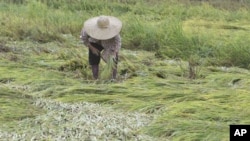Food prices are rising in Asia, and governments are taking various measures to keep them under control - from price ceilings to export restrictions. But uncoordinated government responses could exacerbate the situation.
Droughts, floods, shortages and increased demand have driven food prices in Asia higher in recent months. And experts say prices could jump even more as one of the world’s largest wheat growers, China, suffers from a dry spell.
As a result, some countries have taken measures to ensure their own supply. India has banned the sale of wheat overseas since 2007, and despite a bumper harvest this season, the government continues to stockpile wheat.
Food prices at "dangerous levels"
This week, the World Bank said food prices have hit "dangerous levels" and have pushed 44 million people into poverty. World Bank President Robert Zoellick urges governments to avoid banning exports or controlling prices, which he says would worsen the problem.
Katsuji Matsunami, a food security specialist at the Asian Development Bank in Manila, says the world is awakening to the danger of food supply vulnerability.
"The food supply system is vulnerable against climate extremes - droughts, floods and so on. In the last few decades, we’ve gotten enough money and all the might and knowledge, but we just simply didn’t do enough to flood-proof Asia’s vast flood plains or climate-proof small farmers from drought. We could have done that, but we didn’t do that," he said.
Agricultural policies partly to blame
Nagesh Kumar, chief economist of the United Nations Economics and Social Commission for Asia and the Pacific in Bangkok, says weak agricultural policies are also to blame.
"Supply has not been keeping pace with rising demand because of neglect of agriculture in government policies over the past two decades. And so agriculture productivity has stagnated," said Kumar.
Asia embraced the agricultural "Green Revolution" of the 1960s and 1970s. But agricultural productivity has generally diminished since then as more farm land was used for homes and factories to accommodate rising populations and industrialization.
According to an Asia Foundation food security report last year, agriculture’s share of the economies of Southeast Asia’s major farm producers - Indonesia, Thailand, the Philippines, Vietnam and Malaysia - has dropped from 38.6 percent in 1970 to 14.5 in 2007. In China, that number fell to 11 percent in 2007 from 35 percent in 1970.
Although the region is home to some of the world’s largest grains growers, more than 64 percent of the world’s undernourished people live here, too.
Governments take measures
In response to expected shortfalls, China pledged cash to farmers to irrigate wheat fields, plant wheat and corn, and treat crop disease. It also set aside $180 million for new equipment and more than $1 billion for drought alleviation.
China also imposed price controls for some food items to shield poor consumers from inflation - which reached 4.9 percent in January.
In Thailand, the government capped the price of cooking palm oil at $1.50 a liter, after floods sharply cut domestic production.
Kumar, however, says that while government intervention may be needed to help the poor, measures such as price controls may spur black market activity.
"If there is a sort of regulation, sort of monitoring along with price controls, it can be very effective, especially if prices are being driven by hoarding or speculation," said Kumar.
Need for coordinated actions
Individual government responses could exacerbate the situation. In early 2008, rice prices more than doubled. Cambodia, Vietnam, India and China, worried about supplies, cut rice exports. At the same time, rice-importing governments ordered large stocks in the international market, driving prices even higher.
Matsunami says there was no real reason for rice prices to skyrocket in 2008.
"Some experts say it was hoarding at every level… But I think more importantly there were various trade restrictive policies taken, export bans and things like that," he said.
So far, except for India, Asian governments have not restricted exports of important commodities. Indian wheat farmers are pressing the government to allow them to sell overseas, which could help increase global supply.
Rice prices are expected to moderate because of an ample harvest and lower demand from the region’s biggest buyer, the Philippines.
Matsunami says having adequate market information helps prevent price volatility. For example, he says the rice trade could benefit from better communication among governments about demand and supply.
"A major part of the rice trade being done within Southeast Asian region is among the Southeast Asian countries," he said. "Is there then a multilateral forum where rice importers and exporters sit together? They don’t have to share the greatest national secret. But can they just sit together and talk casually, ‘How do you see the outlook? How do you see your country’s rice market now?’ That kind of forum does not exist."
Regional food banks
Experts also push for the creation of regional food banks that nations can draw on at times of shortages as a way to prevent a sudden spike in prices.
The 10-member Association of Southeast Asian Nations, China, South Korea and Japan have established a rice reserve but only for emergency humanitarian needs.
The eight-member South Asian Association for Regional Cooperation has yet to make its regional food bank fully operational despite an agreement in 2007.










